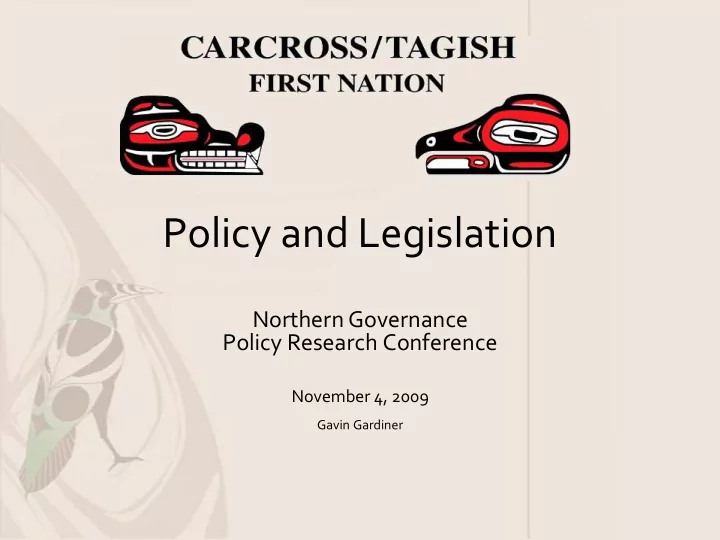

Policy and Legislation Northern Governance Policy Research Conference November 4, 2009 Gavin Gardiner
Presentation Outline • CTFN Background • CTFN Approach and Philosophy • Research Implications
“This is about a legacy. It is both a legacy that our ancestors taught us, and it is about a legacy to our future generations as well.” Khà Shâde Héni Mark Wedge (2005) speaking on CTFN legislation.
CTFN Background • 11 of 14 Yukon First Nations have signed Final (FA) and Self- Government Agreements (SGA). • All based on the Umbrella Final Agreement (UFA) signed in 1993 after 30 years of negotiating. • Carcross/Tagish First Nation the last YFN to sign the agreements. • FA and SGA were ratified in in 2005 and became effective in January 2006. • Ownership and management of over 1,500 square kilometers of land. • Legislative authority in over three dozen areas of jurisdiction both citizen and land based.
CTFN Approach to Governance • State of the Nation – 1997 • Constitution – 1998 • Clan Based Research Project – 2000/2001 • Governance Reorganization – 2006
Clan Based Governance • Kookhittaan - Crow Moiety • Ishkaahittaan- Crow Moiety • Yan Yeidi - Wolf Moiety • Gaanaxteidi - Crow Moiety • Deisheetaan - Crow Moiety • Daklaweidi - Wolf Moiety
Clans • Clans are the basis of community decision making. • Basis for all CTFN appointments to boards and committees. • Matriarchal • Auyxaudi (House Masters)
Administrative Structure Based on the Medicine Wheel
Cube Philosophy • A three dimensional check list. • All laws, projects, programs and policies must be mindful of the emotional, spiritual, physical and mental elements of an individual through all stages of life: infants, youth, adults and elders.
Values and Virtues
CTFN Approach to Legislation • Guided by the underlying philosophy of the CTFN Government. • Legislation is drafted to be not only accessible but a cultural, educational and healing tool for widespread community consumption. • Attempts to meld traditional laws and oral history with western legal standards.
Book One • “Traditional Beliefs and Practices: Our Place, Our Responsibilities.” • Serves as a template and guiding document for all future Books of Law. • A history of the Nation and an outline of the philosophy. • Passed at the November 2008 General Council.
Book Two • Traditional Family Beliefs and Practices or “The Family Act”. • Deals with child protection and support for families at risk. • Creates opportunities for a community to raise a child. • CTFN’s flagship legislation
Unique aspects of the Act • Traditional Stories • Contemporary Stories • Our Beliefs • Elder Quotes
Primary Principle – The Best Interests of the Child The best interests of the child is paramount but not the exclusive principle governing the nurturing of children. • Secondary Principles • Importance of supporting and preserving our families. • Measures taken to maintain and to reestablish connections. • Families and clans are the primary caregivers and protectors of children. • Recognize and respect the rights of children, natural parents, families and clans in all our processes. • Support all parties. • Look to our traditional practices.
Process continued. • Traditional responsibilities based on values • Community first resort • Government/Court last resort • Mandates at every stage in process: • Return to previous level of responsibility • Engage family, clan, community • Shared track of responsibility • Process for proactive self correction/accountability: » Self » Family » Clan » Community » ----------------------- Court/Tribunal
Research Implications • Reconciling Philosophy • Codifying Oral History and Traditions • Path of Least Resistance • Politics of Small Communities. * Following views are strictly my own and do not represent the views of the Carcross/Tagish First Nation
Reconciling Philosophy Western approach to Community based policy and research approach to policy and research - Based on values and - Based on mitigation of virtues. liability. - Living documents. - Rigid. - Inclusive. - Inaccessible.
Codifying Oral History and Traditions • Is not without controversy, even when done by trusted citizens of the First Nation. • Stories and knowledge around certain areas should not be for general public consumption. • Some believe any attempt to meld the western and traditional compromises the traditional.
Path of Least Resistance • Capacity and fiscal restraints often dictate the direction of government policy and research. • Building new governments based on a community based philosophy is time and cost consuming. Copying western models is less so. • Competition is present where cooperation should exist.
Politics of Small Communities. • aka there are no ivory towers in Carcross. • Policy and research are not conducted in a vacuum. • The visceral nature of politics in small northern communities has an impact on the policy and research outcomes.
Thank you Gunalchéesh
Recommend
More recommend